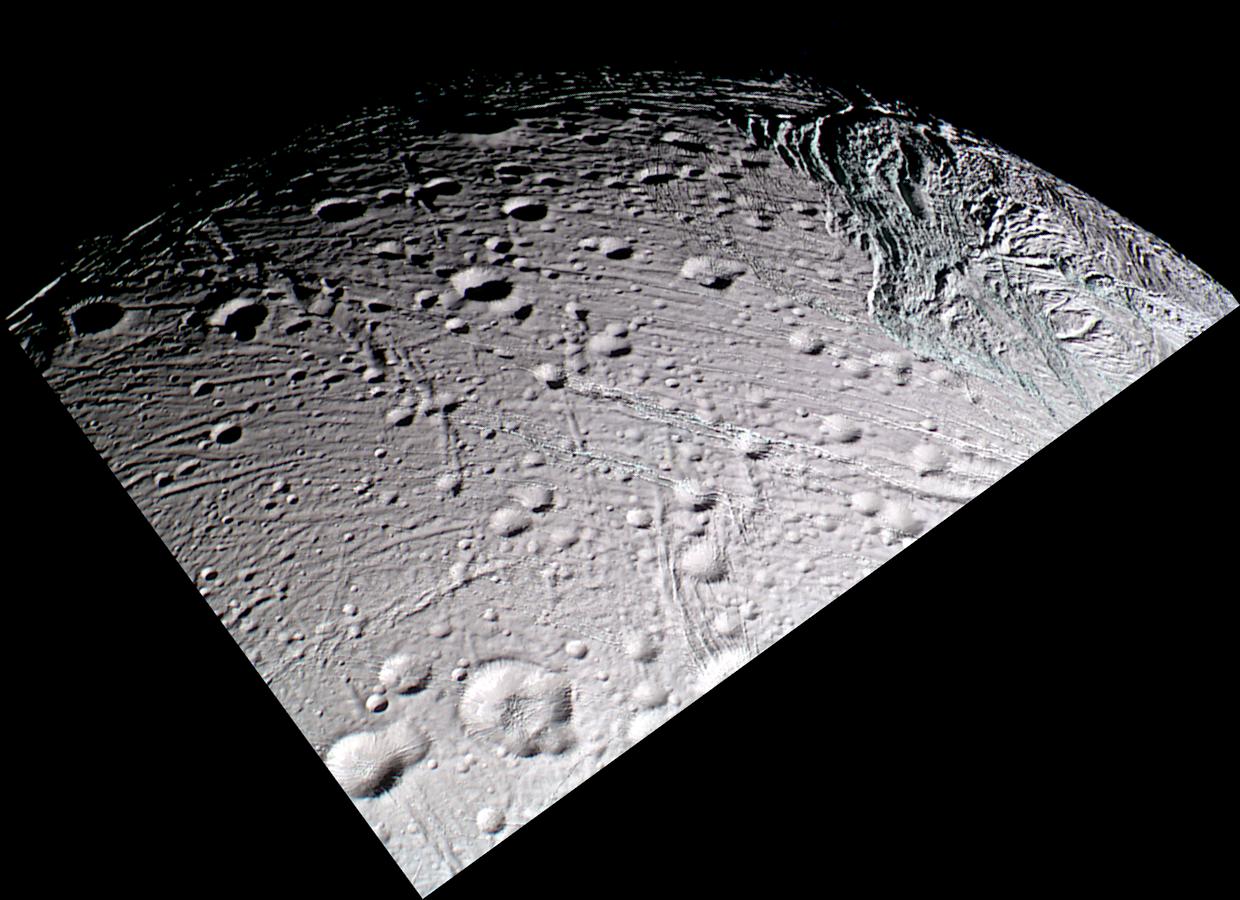Old and New Again

| PIA Number | PIA06207 |
|---|---|
| Language |
|
This false-color Cassini mosaic of Saturn's moon Enceladus captures in a single view, much of the frigid moon's diverse geology.
Cratered terrain dominates most of the scene. The relatively dense accumulation of impact craters implies that this terrain is among the oldest on the moon's surface. Near the bottom of the picture is a crater 20 kilometers wide (12-mile) with a prominent dome-shaped structure in its center. The entire area is transected by a complex web of fractures and faults; some are as narrow as a few hundred meters, others as wide as 5 kilometers (3 miles).
The rims and interiors of many craters seem to be sliced by a pervasive system of narrow, parallel grooves into slabs or lanes that typically are a kilometer (about a half-mile) in width. The widely varied appearances of fractures in this region attest to the fact that the surface of Enceladus has been shaped by a long history of intense tectonic activity. The oldest fractures are characterized by a soft, muted appearance and are overprinted by numerous, superimposed impact craters. More recent fractures exhibit topographic relief that is relatively "crisp" in appearance, and they appear to slice through pre-existing impact craters and older fractures.
On the right side of the image is a conspicuous and twisted network of ridges and troughs forming a distinct tectonic region on Enceladus. The paucity of craters and the sharp appearance of the topography in this area indicate that this is a relatively young terrain on Enceladus.
This view is a composite of images taken using filters sensitive to ultraviolet (centered at 338 nanometers), green (centered at 568 nanometers), and near-infrared (centered at 930 nanometers) light, and has been processed to accentuate subtle color differences. The uppermost surface of these terrains has a relatively uniform grayish color in this picture, suggesting that it is covered with materials of homogeneous composition and grain size. However, many of the fractures reveal a distinctly different color (represented by pale-bluish tones in this false-color image) than the typical surface materials. These "colored" fractures seem to penetrate down to a material that is texturally or compositionally different than most of the material at the surface.
One possibility is that the walls of the fractures expose outcrops of solid ice, or ice with different grain-sizes compared to powdery surface materials that blanket flat-lying surfaces. It is also possible that the color identifies some compositional difference between buried ice and ice at the surface. The distinct coloration of "youthful" fracture walls are nearly absent in the oldest fractures. This is consistent with the possibility that the older fractures are covered with a drape of particulate material which mantles nearly all the oldest features on the satellite.
In the early 1980's, NASA's Voyager mission to the outer planets revealed a strikingly similar arrangement of terrains on Miranda, an icy moon of Uranus (see PIA 00141). Miranda is 470-kilometers-wide (290 miles), nearly as large as Enceladus (504 kilometers, or 313 miles wide). The similarities in size and tectonic history on these objects may suggest that remarkably similar physical processes have controlled the separate geological evolutions of these bodies.
The images that comprise this mosaic were obtained during Cassini's closest approach to Enceladus on March 9, 2005. The images was taken in visible green light with the Cassini spacecraft narrow-angle camera at a distance of approximately 29,000 kilometers (18,000 miles) from Enceladus and at a Sun-Enceladus-spacecraft, or phase, angle of 46 degrees. Resolution in the original images is about 170 meters (560 feet) per pixel.
The Cassini-Huygens mission is a cooperative project of NASA, the European Space Agency and the Italian Space Agency. The Jet Propulsion Laboratory, a division of the California Institute of Technology in Pasadena, manages the mission for NASA's Science Mission Directorate, Washington, D.C. The Cassini orbiter and its two onboard cameras were designed, developed and assembled at JPL. The imaging team is based at the Space Science Institute, Boulder, Colo.
For more information about the Cassini-Huygens mission visit http://saturn.jpl.nasa.gov . For additional images visit the Cassini imaging team homepage http://ciclops.org .
Credit: NASA/JPL/Space Science Institute
